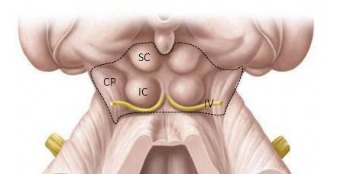Quadrigeminal plate
 The quadrigeminal plate, also known as the tectal plate, is the portion of the midbrain tectum upon which the superior colliculus and inferior colliculus sit.
The quadrigeminal plate, also known as the tectal plate, is the portion of the midbrain tectum upon which the superior colliculus and inferior colliculus sit.
The tectum is the dorsal portion of the midbrain (brainstem) and is derived in embryonic development from the alar plate of the neural tube. Masses in the region of the tectum can cause obstruction of the cerebral aqueduct resulting in obstructive hydrocephalus.
Variations of the quadrigeminal plate (mesencephalic tectum) were determined on midline sagittal MR images of the brain in 93 patients without known mesencephalic abnormalities and in 10 patients with known aqueductal stenosis or obstruction. Measurements of the thicknesses of the superior and inferior colliculi and the length of the tectum were made on the midline sagittal section. Images were obtained with a 0.5 T system with spin-echo pulse sequences using a TE of 30 or 40 msec with a TR of 500-1500 msec. The average thickness of the superior and inferior colliculi was about 5 mm, but the range was from 2-7 mm on the midline sagittal section. Abnormally thin colliculi appeared to have no clinical significance while abnormal thickness was observed in patients with neoplastic disease, sarcoidosis, and mesencephalic “beaking.” While most neoplasms have abnormal signal intensity on T2-weighted images, small lesions may be difficult to perceive on transaxial images due to volume averaging or noncontiguous sections. Measurements of the tectum, on the commonly obtained midline sagittal section, may be useful for patients with small infiltrative lesions 1).
A pineal region tumor, pressing the quadrigeminal plate, can cause Parinaud syndrome.
see Tectal glioma